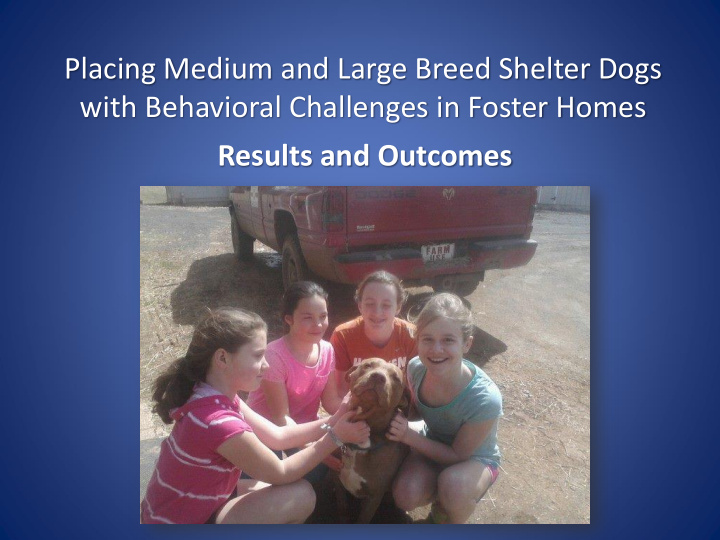



Placing Medium and Large Breed Shelter Dogs with Behavioral Challenges in Foster Homes Results and Outcomes
Kristen Auerbach, MA Deputy Director, Austin Animal Center Formerly Assistant Director, Fairfax County Animal Shelter Fairfax, Virginia
Part I BACKGROUND
• Fairfax County Animal Shelter is an open-access, municipal animal shelter that falls under the Fairfax County Police Department in Fairfax, Virginia • Shelter serves 1.2 million people over 400 square miles • Average annual intake between 4,000 and 5,000 animals • Live outcomes anticipated to be 90% in 2015 Washington, DC Fairfax, Virginia
Prior to 2012: • Euthanizing for space and time limits for adoption for some animals • ‘Pit bull’ adoption restrictions up to 80% of pit bull dogs euthanized • Euthanizing for common behavioral challenges • Euthanized dogs for ‘failing’ SAFER evaluation • Euthanized 25% of animals entering shelter. Sample Outcomes List – Open access shelter in Maryland 2015
Beginning in 2013: • Worked towards ending euthanasia based on perceived breed • No euthanasia for ‘failing’ standardized behavior evaluation • Shelter began implementing enrichment, playgroups, adult dog foster program
Restrictions on ‘pit bull’ adoptions overturned January 2014
Lifesaving programs for shelter dogs Adult Dog Fostering Play Groups
Dog with behavioral challenges No behavior staff or Declining behavior rescue placement over time options Concerns from staff, volunteers, ACOs
Part II THE STUDY
Patty’s story…
The Dogs May 2013 to March 2015 52 medium/large shelter dogs of various breeds and types • No viable placement options because of behavioral challenges in shelter • Not severely aggressive towards people or animals
16 Foster Families • Characteristics • Number of dogs they fostered • What the foster families agreed to
Study objectives 1. Could we place medium and large dogs with behavioral challenges in foster homes and see their behavior improve? 2. Could these dogs eventually be adopted into permanent homes? 3. Could we do all of this safely?
What we studied • Ages • Primary and secondary behavioral issues • Duration of stay in foster • Outcome - adopted or euthanized • Reasons for euthanasia • Rate of and reasons for return • Any behavioral challenges experienced by – Foster families – Adopters • Status of dogs six months to 18 months after adoption
Age Over 80% of dogs were 3 years and under
Primary Behavioral Issues
Secondary Behavioral Issues 10 - extremely energetic 4 - possibly dog aggressive 2 - dog selective 2 - afraid of men 2 - under-socialized 2 - displayed separation anxiety 1 - reactivity
How long did the dogs stay in foster? 88% of the dogs were in foster 30 days or less. Place of Adoption: • 33 adopted directly from the foster home • 16 returned to shelter and subsequently adopted
Live Outcomes 90.4%
Returned Adoptions Six dogs (11%) adopted/returned prior to foster Three dogs (6%) sent to foster, adopted, returned and re-adopted Two dogs (4%) sent to foster, adopted, returned and euthanized Return rate of dogs in study: 9.6% Overall return rate of adopted dogs: 13%
Part III. DISCUSSION
Here’s what the fosters said about their experiences… 1. They felt well-informed about issues prior to taking dogs home 2. They felt they either did not witness the behavior described to them or they stated the described behavior diminished or disappeared within a week 3. They said sometimes new behavioral issues emerged over time 4. They felt trainer support and someone to consult was key
Adopter Follow-up We called our adopters six to 18 months following adoption and asked them four questions…
1. Is this dog still in your home? 96% of respondents said YES!* * respondents represent the final, adoptive homes. Some dogs adopted, returned and re-adopted.
2. Did you experience any challenges? “Barks a lot, digs and pulls too much.” “Needs training and will run away if off leash but so loving” “Afraid of cars. Wants to chase them but scared.” “Sometimes he’s a bit naughty. Chewing on things” “None. She fits right into the family and bonded with our other dog.” “Mindy is a handful and she’s great with our family but experiences anxiety and is fearful around some men.” “Bella has severe anxiety. She hasn’t left the house since the day she came home.” “No behavioral issues, but she has skin allergies.”
3. Would you re-adopt this dog? “Yes. Dogs are dogs.” “No. not knowing what we know now. But we love Mindy and have no intention of giving her up.” “Yes, in a heartbeat.” “No. We love her very much but we wouldn’t adopt a young dog again because of the need for exercise and training.” “Oh yeah. Absolutely. He’s perfect.” “I love him now but in the beginning I would have opted for another dog if I had known about his skin allergies.”
4. Could we have offered you more support? • Basic training • Training support immediately following adoption • Someone to call to help them ‘troubleshoot’ behavior issues
• Six out of the 51 dogs were adopted by their foster family • What word did fosters use more than any other to describe their foster dogs? • In most cases, fosters met with potential adopters
Dogs Helping Dogs • Dogs socialized with other dogs • Playgroups played a key role in identifying dogs with shelter-based behavioral issues • All dogs were evaluated with other dogs off leash
Study Objectives results 1.Could we place medium and large dogs with behavioral challenges in foster homes and see their behavior improve? 2.Could these dogs eventually be adopted into permanent homes? 3.Could we do all of this safely?
THANK YOU! Find me on Twitter @KEADasher And on Facebook, LinkedIn, and Instagram. Kristen.auerbach@ Austintexas.gov
Recommend
More recommend